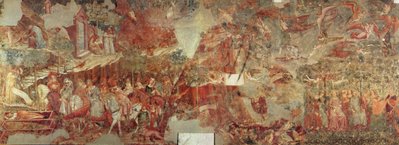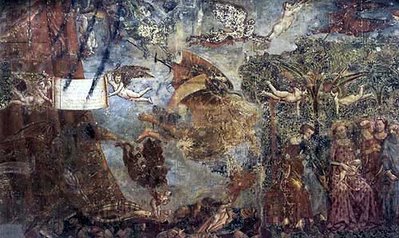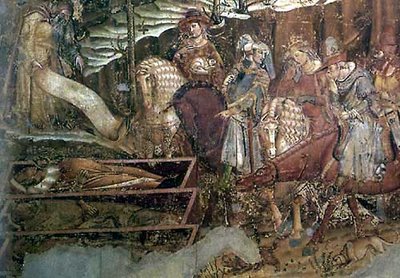Aeneas lived after The Black Death ravaged Western Europe. The effects of The Black Death were profound for the times of Aeneas. Recurrences of "The Plague" recurred and are mentioned in The Commentaries.
The Times Literary Supplement (November 2nd, 2006) has published a review of a new book on the plague and Black Death.The book is Ole J. Benedictow, THE BLACK DEATH, 1346–1353: The complete history 433pp. Boydell Press. £20. The review is by Angus Trumble.
The review itself is highly instructive. It is at http://tls.timesonline.co.uk/article/0,,25340-2432149,00.html
Below are details from the fresco The Triumph of Death, the work of an unknown master, called Maestro del Trionfo delle Morte in The Campo Santo in The Piazza dei Miracoli in Pisa, Italy. But on 27 July 1944, incendiary bombs dropped by Allied aircraft set the roof on fire and covered them in molten lead, all but destroying them. Since 1945 restoration works have been going on and now the Camposanto has been brought back to its original state.
The celebrated frescoes, the Triumph of Death, with accompanying scenes of the Last Judgment, Hell, and Legends of the Hermits were attributed for long time to Francesco Traini. The destruction in 1944 did allow the uncovering of the beautiful 'sinopie`, which are now shown in the Museo delle Sinopie, again in the Piazza dei Miracoli in Pisa (entrance behind the market stalls).
The frescoes include many telling details of death's victims and are usually seen as a reflection of the horrors of the Black Death of 1348 and were thought to be the work of Traini. But some authorities consider them earlier and attribute them to the mysterious Buffalmacco: Buonamico di Martino or Buonamico Buffalmacco (active c. 1315–1336). He was an Italian painter who worked in Florence, Bologna and Pisa. None of his known work has survived.



